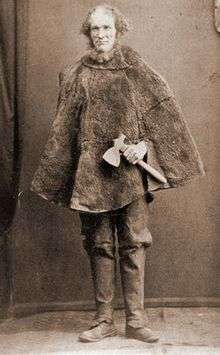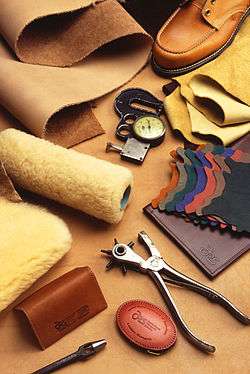Kangaroo leather
Kangaroo leather is a strong light weight leather derived from the hide of the kangaroo.
Kangaroos are harvested.[1][2] Both the meat and the hides are sold. Although most species of macropod are protected from hunting by law, a small number of the large-sized species which exist in high numbers can be hunted by commercial hunters.[3] This policy has been criticised by some wildlife activists.[4]
Applications

The leather is used in a wide variety of shoes.[5] The unique structure of kangaroo leather allows it to be cut down to very thin substance (thickness of the leather) but still retain strength.[5]
Kangaroo leather is also popular in the manufacture of motorbike leathers and is used in a wide variety of other applications such as car upholstery, military boots, football or soccer boots and fashion accessories.[6][7]
Kangaroo leather is the material of choice for whip makers as the strips can be cut thin to keep the whip flexible, without sacrificing durability.[8]
Properties
Studies conducted by the Australian Commonwealth Scientific and Industrial Research Organisation (CSIRO) confirm that kangaroo is one of the strongest leathers of similar substance available.[5][9]
Similarly when split into thinner substances kangaroo retains considerably more of the original tensile strength of the unsplit leather than does calf. When split to 20% of original thickness kangaroo retains between 30 and 60% of the tensile strength of the unsplit hide. Calf split to 20% of original thickness, on the other hand, retains only 1–4% of original strength.[9]
Kangaroo leather is lighter and stronger than the hide of a cow or goat. It has 10 times the tensile strength of cowhide and is 50% stronger than goatskin.[10]
Studies of the morphology of kangaroo leather help explain its particular properties.
The collagen fibre bundles in cattle hide are arranged in a complex weaving pattern. The fibres are often at angles as much as 90 degrees to the skin surface. Cattle hide also contains sweat glands, erector pili muscles and a distinct gradation in elastin levels, concentrated in the upper part of the skin. Kangaroo hide on the other hand has been shown to have a highly uniform orientation of fibre bundles in parallel with the skin surface. It does not contain sweat glands or erector pili muscles and elastin is evenly distributed throughout the skin thickness.[11] This structural uniformity explains both the greater tensile strength of the whole leather and the greater retention of strength in splits. Bovine skin is much more complex in cross section. Hence in whole section it has many more weak points from which tears can start when placed under tension. In addition when sliced into splits the collagen fibres running at significant angles to the skin surface will be cut. These then become weak points in the structural strength.
Environmental aspects
The Australian kangaroo industry produces a range of meat and leather products from animals harvested from the wild under strict government controlled Management Plans. These ensure the harvest is sustainable and humane.[12] A wide cross section of Australian ecologists support the kangaroo industry as being both sustainable and environmentally wise.[13] Many argue kangaroos, which are native to Australia, are a more environmentally friendly livestock option than introduced sheep and cattle.[14] The two most important facets of kangaroos' better ecological fit than European agricultural animals relate to their adaptation to Australia's aridity. Kangaroos have small chest development and so require less water to breathe than placental mammals, which usually must expand a diaphragm. This means they lose more moisture in respiration. Kangaroos just make small pants while immobile, and in motion expand and contract their lungs effectively using their leg muscles. The belly flops up and down, contracting and expanding the lungs respectively. Also, the kangaroo's paw is softer and does not compact the ground as hoofed cattle and sheep do. Instead, its hopping leaves very small bowl-shaped cuts in the surface of even dry clay soil, which let native grass seeds carried on the wind settle into them. The bowl shape concentrates any moisture that may fall into it into a wet point that the grass seed can use to germinate. Thus, kangaroos deplete the water table at a slower rate than cattle or sheep and would even be viable in the absence of any bore water at all. The ecological arguments for kangaroos replacing sheep and cattle as arid land livestock are compelling, though they must be set against objections of kangaroos' lack of domestication and breeding rate. Kangaroos are eaten in most states.
Gallery
_rufogriseus_fur_skin.jpg) Red-necked wallaby pelt
Red-necked wallaby pelt Moondyne Joe wearing a kangaroo-skin cape
Moondyne Joe wearing a kangaroo-skin cape Noongar man in traditional kangaroo-pelt clothing
Noongar man in traditional kangaroo-pelt clothing.jpg) Kangaroo fur coat
Kangaroo fur coat
See also
References
- "Eat kangaroo to 'save the planet'". BBC News. 9 August 2008. Retrieved 17 December 2017.
- Dow, Steve (26 September 2007). "An industry that's under the gun". Sydney Morning Herald. Retrieved 19 August 2008.
- "Kangaroo Biology". Deh.gov.au. Archived from the original on 29 January 2007. Retrieved 12 January 2013.
- "SaveTheKangaroo.com". SaveTheKangaroo.com. Retrieved 12 January 2013.
- Looney, Mark; Kyratzis, Ilias (Louis); Truong, Yen; Wattssenberg, Jacinta (August 2002). "Enhancing the Unique Properties of Kangaroo Leather". RIRDC Publication No 02/105 RIRDC Project No CWT-1A. Rural Industries Research & Development Corporation (Australian Government Statutory Corporation). Archived from the original (Summary of report with link to full report) on 28 July 2008. Retrieved 26 August 2008.
- "Leather Products | Packer Leather | Performance Leathers | Australia". Packer Leather. Retrieved 12 January 2013.
- "Kangaroo leather jewellery by Jaroo Designs - bracelets, necklaces, belts". Jaroo.com.au. 30 November 2012. Retrieved 12 January 2013.
- "Tips on choosing your first whip by Paul Keith". Bullwhip-info.com. Retrieved 12 January 2013.
- Stephens, L.J. (1987). "Stratigraphic analysis of kangaroo leather". Journal of the American Leather Chemists Association. 82 (2): 41–44.
- Archived March 6, 2012, at the Wayback Machine
- (Bavinton et al. 1987) A comparative morphology of kangaroo and bovine leather. J. Am. Leather Chem. Ass
- Conserving the Kangaroo http://www.environment.gov.au/biodiversity/trade-use/wild-harvest/kangaroo/biology.html#kancons
- The kangaroo industry - ecologists and conservationists "Archived copy". Archived from the original on 22 July 2008. Retrieved 21 August 2008.CS1 maint: archived copy as title (link)
- FATE Program "Archived copy". Archived from the original on 28 August 2008. Retrieved 15 September 2008.CS1 maint: archived copy as title (link)
